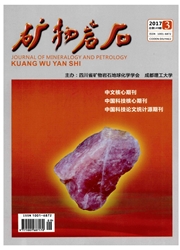

 中文摘要:
中文摘要:
以咸阳城区蓝田灞河组孔隙型热储流体为研究对象,应用环境同位素法、离子比分析法对其同位素分布规律、富集趋势以及水化学类型进行分析,确定其同位素水文地球化学特征,并对其成因类型进行论证。研究中发现受控于沿渭河东西向深大断裂的南北热储流体,其水化学特征各异而同位素差异不大,北部水化学类型单一,全部为Na—Cl型水,南部Na+,HCO3-和SO4^2-含量较高,水化学类型复杂,体现出研究区地下热储环境形成过程的复杂性。同位素结果显示咸阳热储流体完全不同于浅层循环地下热水,可能为赋存混入古溶滤水的残存沉积水,亦或为混入残存沉积水的古溶滤水。
 英文摘要:
英文摘要:
In this article,the porous geothermal fluid of Lantianbahe Formation in the Xianyang area is analyzed by environment isotope method as well as iron ratio method. The hydrogeochemi- cal characteristics of geothermal fluid of studied area are confirmed and its genesis is discussed through studying the isotope enrichment of the trend, distribution and hydrogeocbemical types. This study not only enriches the hydrogeochemical characteristics and genetic type awareness but also provide a logical proof for sustainable development and utilization of porous geothermal fluid. It is showed that the geothermal fluid in both sides of East-west fault zone exist big difference a- bout hydrogeochemical characteristics but slight diversity about isotopes. Northern hydrogeo- chemical type of the fault all belongs to Na-C1 type,on the contrary, southern is more complex, characterized by higher Na+ , HCO3 - and SO42- content in the thermal water. The different fea- tures indicate that Xianyang the formation of reservoir environment have a complex process. The isotopic research result shows that the deep geothermal fluid of Xianyang area is totally different from shallow circulating thermal water,indicating that the geothermal water maybe a kind of re- sidual sedimentary water mixed with infiltration water hosted on a relatively closed thermal envi- ronment, or a kind of infiltration water mixed with residual sedimentary water.
 同期刊论文项目
同期刊论文项目
 同项目期刊论文
同项目期刊论文
 Origin and classification ofgeothermal water from Guanzhong basin, NW China: geochemical and isotopi
Origin and classification ofgeothermal water from Guanzhong basin, NW China: geochemical and isotopi Isotope and chemistry study for genetic types of geothermal water in Gushi depression, Shaanxi Provi
Isotope and chemistry study for genetic types of geothermal water in Gushi depression, Shaanxi Provi 期刊信息
期刊信息
